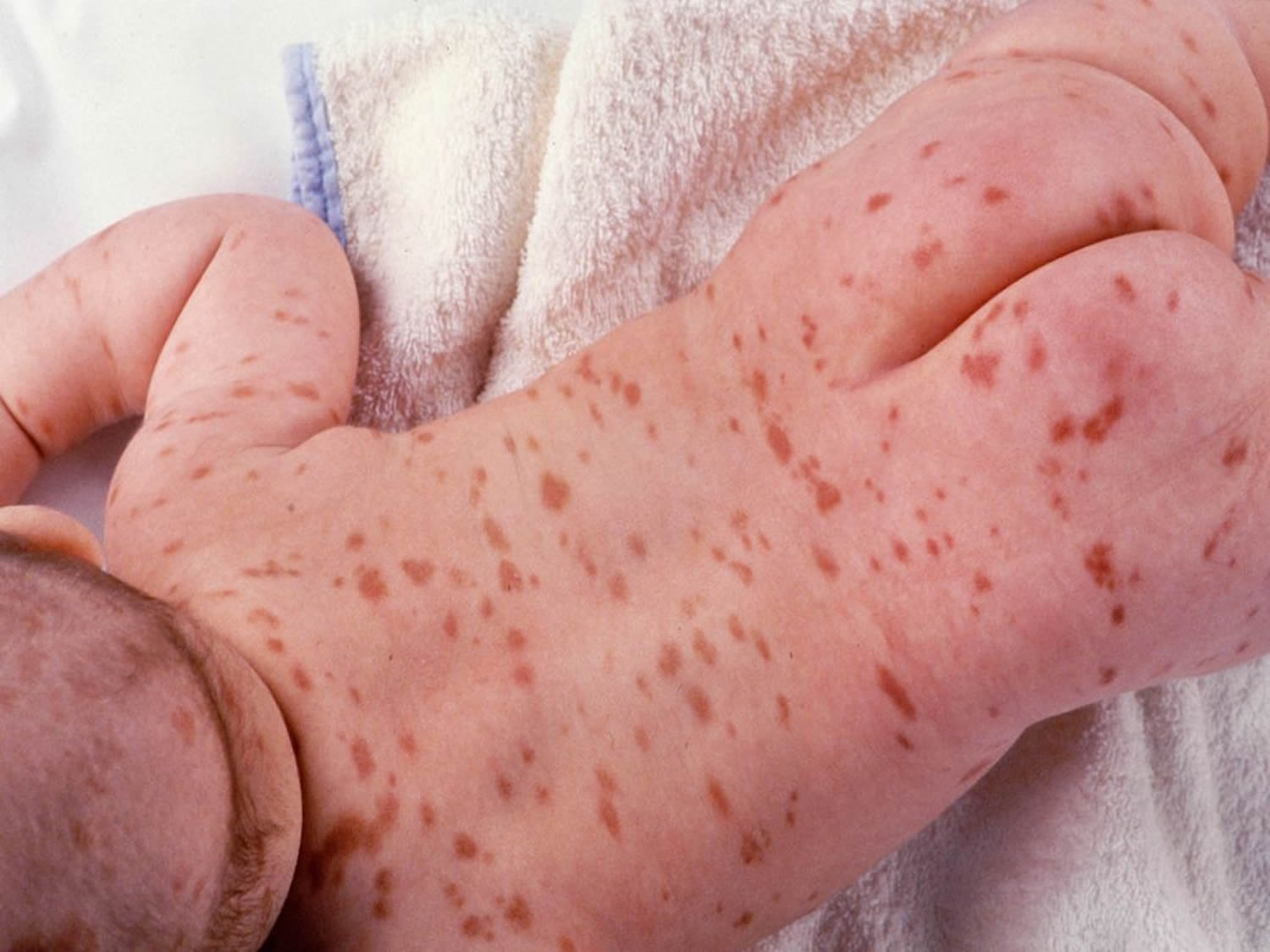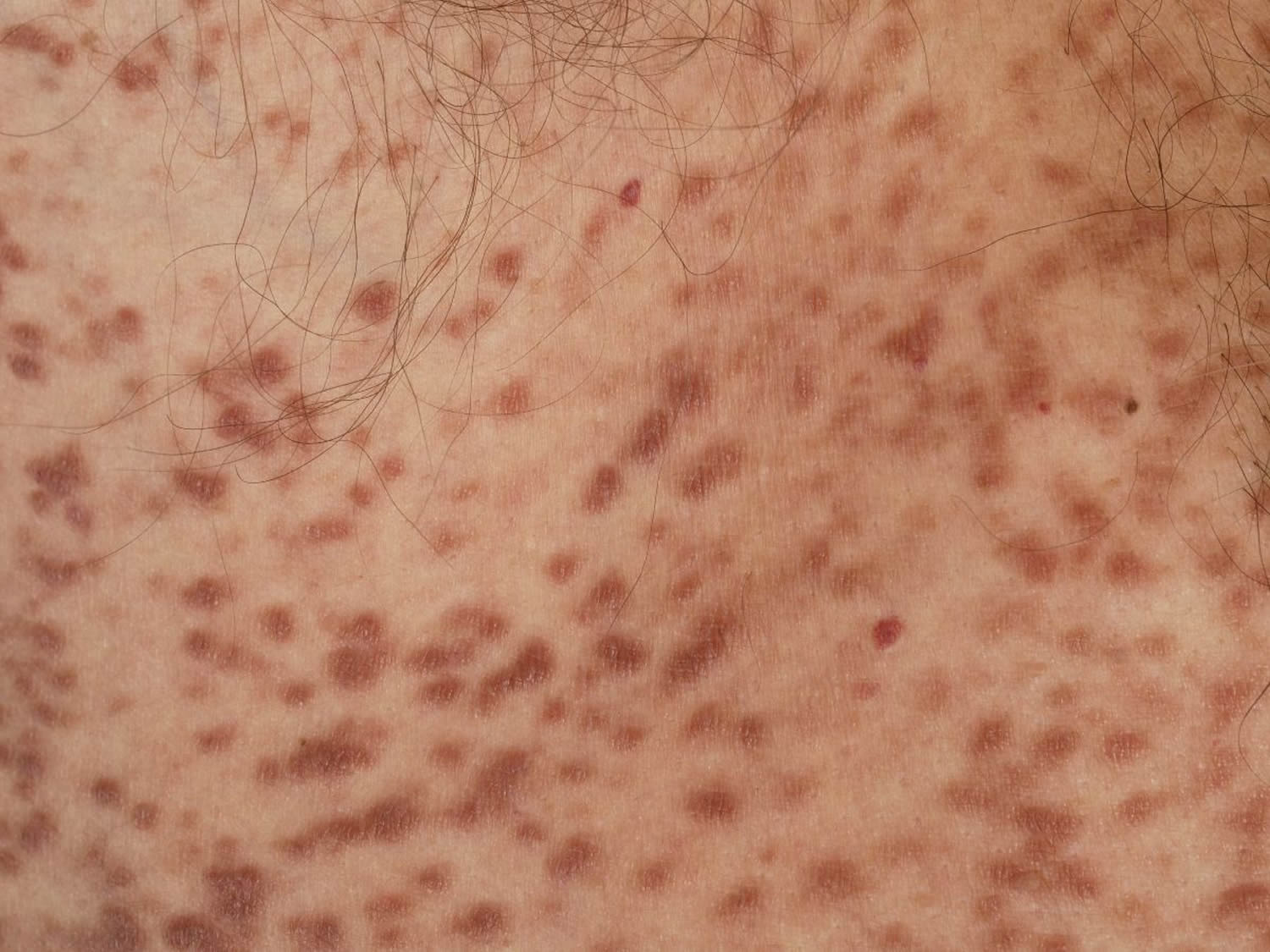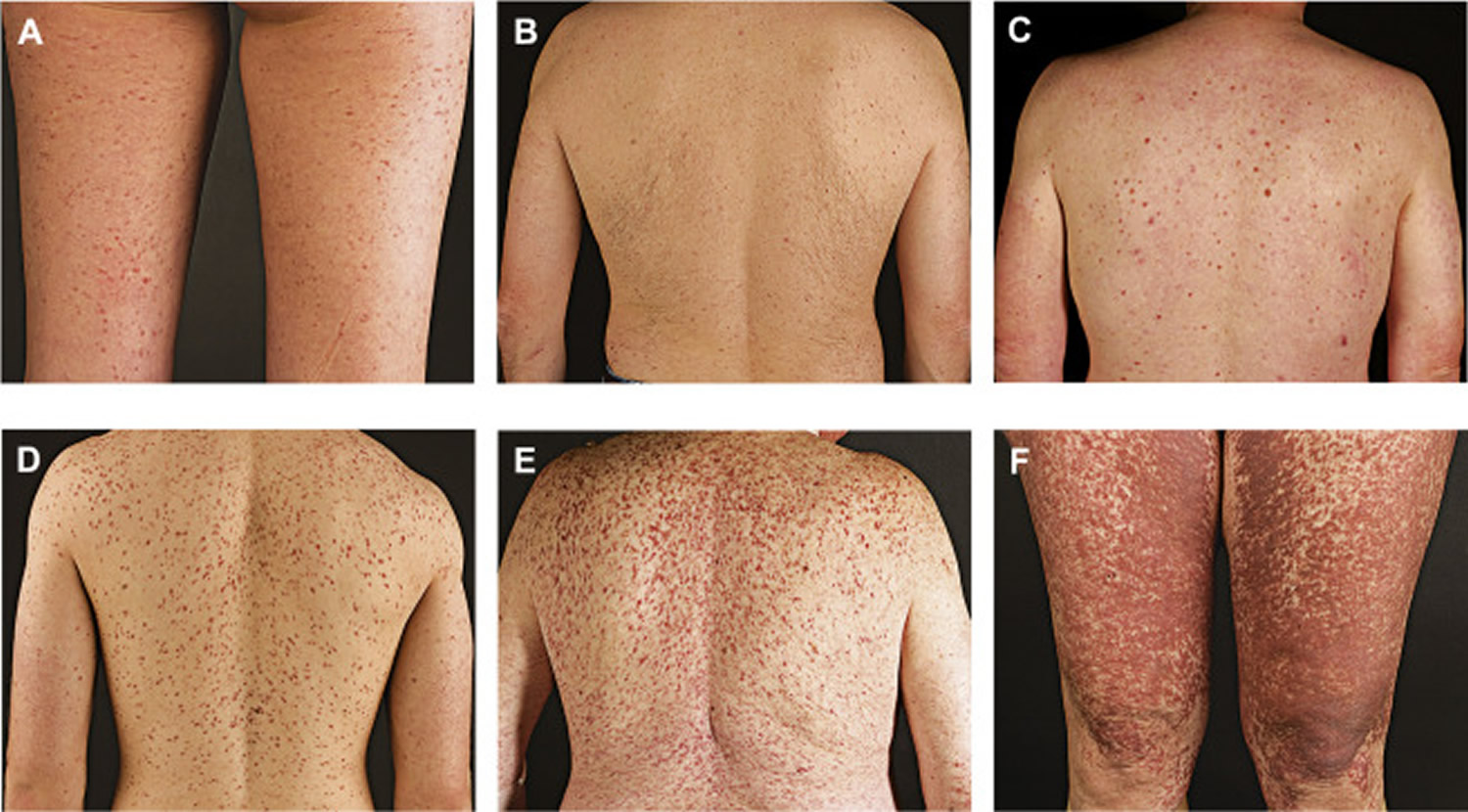Contents
What is urticaria pigmentosa
Urticaria pigmentosa also known as maculopapular cutaneous mastocytosis, is a skin disease that produces many brownish spots or patches of darker skin and very bad itching – when scratched, produce welts and reddened skin 1. It is the most common type of cutaneous mastocytosis, a condition where there are brown patches or freckles on the skin due to abnormal collections of mast cells 2. Urticaria (hives) can develop when these skin areas are rubbed. Individuals sometimes develop flushing and headache resulting from the massive release of histamine from these spots.
Maculopapular cutaneous mastocytosis most often affects infants (see Figure 1), with the first patches appearing at a few months of age. The patches are often confused with moles or with insect bites at first, but the lesions persist and gradually increase in number for several months or years. They can appear on any part of the body including the scalp, face, trunk and limbs.
In young children, it is common for the urticaria pigmentosa patches to blister when rubbed. If many patches are rubbed or activate spontaneously at the same time, the infant may become irritable, but is uncommon for severe symptoms to arise.
Over time, the urticaria pigmentosa becomes less itchy and eventually the patches fade away. By the teenage years, most patches will have gone.
Figure 1. Urticaria pigmentosa

Figure 2. Urticaria pigmentosa (close up)

Urticaria pigmentosa in Adults
Maculopapular cutaneous mastocytosis can sometimes develop for the first time in an adult. Just a few lesions may appear or many. The lesions can be unsightly and itchy. Unfortunately, in adults, urticaria pigmentosa tends to persist long-term. Sometimes patients can have systemic symptoms (such as flushing, itching, low blood pressure, anaphylactic shock, diarrhoea and bleeding from the gastrointestinal tract), which suggest the presence of systemic mastocytosis.
Localised cutaneous mastocytosis has rarely been reported to arise in an area of radiation treatment for breast cancer for unknown reasons.
Figure 3. Urticaria pigmentosa (adults)

Causes of Urticaria pigmentosa
Urticaria pigmentosa occurs when there are too many inflammatory cells (mast cells) in the skin. Mast cells are immune system cells that help the body fight infections. Mast cells make and release histamine, which causes nearby tissues to become swollen and inflamed.
Urticaria pigmentosa is most common in children. It can also occur in adults.
Things that can trigger histamine release and skin symptoms include:
- Rubbing the skin
- Infections
- Exercise
- Drinking hot liquids, eating spicy food
- Sunlight, exposure to cold
Certain medications can cause mast cell degranulation and should be avoided if there is extensive urticaria pigmentosa.
These include:
- Aspirin (salicylates) and other nonsteroidal anti-inflammatory drugs (NSAIDs)
- Codeine and morphine (narcotics)
- Alcohol
- Anticholinergics
- X-ray dye,
- Some anesthesia drugs,
- Alcohol
Exercise or heat can aggravate symptoms of cutaneous mastocytosis. A severe reaction can result in flushing and faintness.
People with urticaria pigmentosa may get a severe allergic reaction from bee or wasp stings, hence they may need to carry an injectable epinephrine/adrenaline kit.
Symptoms of urticaria pigmentosa
The main symptom is brownish patches on the skin. These patches contain histamine. When histamine is triggered, the patches develop into hive-like bumps. Younger children may develop a blister that is filled with fluid if the bump is scratched.
The face may also get red quickly.
In severe cases, these symptoms may occur:
- Diarrhea
- Fainting (uncommon)
- Headache
- Rapid heartbeat
Diagnosis of urticaria pigmentosa
The health care provider will examine the skin. Your doctor may suspect urticarial pigmentosa when the skin patches are rubbed it typically urticates, becoming pruritic (itch), edematous (swelling) and erythematous (redness) – this is called the Darier sign.
Tests to check for this condition are:
- Skin biopsy to look for a higher number of mast cells
- Urine histamine
- Blood tests for blood cell counts and blood tryptase levels (tryptase is an enzyme found in mast cells)
- DEXA bone scan
- Bone marrow examination
Treatment of urticaria pigmentosa
Urticaria pigmentosa (maculopapular cutaneous mastocytosis) is not serious and does not require any treatment in most cases (unless there is also systemic involvement).
Antihistamine medicines can help relieve symptoms such as itching and flushing. Talk to your doctor about which type of antihistamine to use. Corticosteroids applied on the skin and light therapy can also be used in some cases.
Your provider may prescribe other kinds of medicine to treat symptoms of severe and unusual forms of urticaria pigmentosa.
The following can be helpful.
- Oral antihistamines
- Topical steroids. Topical steroids are only suitable for limited areas.
- Potent steroid creams applied for several months under occlusion can reduce itching and unsightliness, but the patches tend to recur within a few months.
- Phototherapy. This form of ultraviolet radiation is the most effective treatment for adults with maculopapular cutaneous mastocytosis. Two or three treatments each week are required for several months. Narrowband UVB or (if available) photochemotherapy (PUVA) lessens the itch and improves the appearance. The cutaneous mastocytosis is likely to recur within six to twelve months.
Outlook (Prognosis) of Urticaria pigmentosa
Urticaria pigmentosa goes away by puberty in about half of affected children. Symptoms usually get better in others as they grow into adulthood.
In adults, urticaria pigmentosa can lead to systemic mastocytosis. This is a serious condition that can affect bones, the brain, nerves, and the digestive system.
Possible Complications of Urticaria pigmentosa
The main problems are discomfort from itching and concern about the appearance of the spots. Other problems such as diarrhea and fainting are rare.
Bee stings may also cause a bad allergic reaction in people with urticaria pigmentosa. Ask your provider if you should carry an epinephrine kit to use if you get a bee sting.
When to Contact a Medical Professional
See your provider if you notice symptoms of urticaria pigmentosa.




